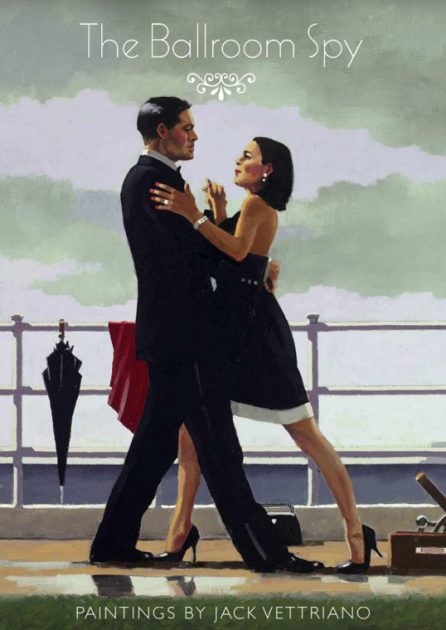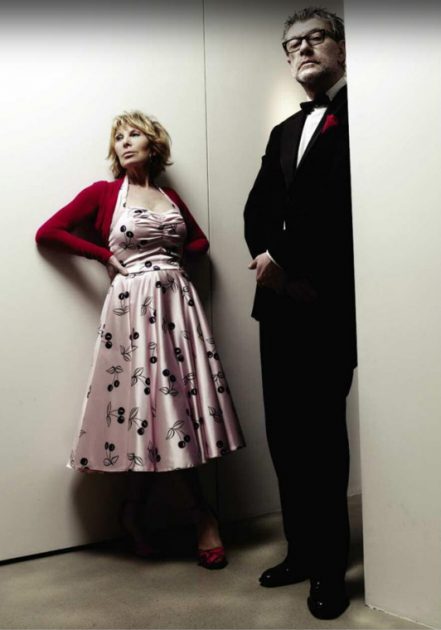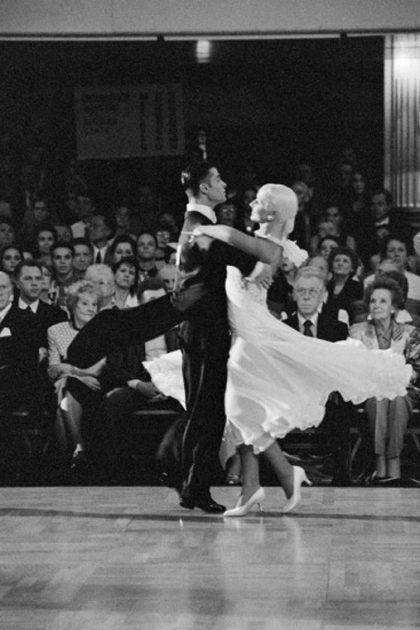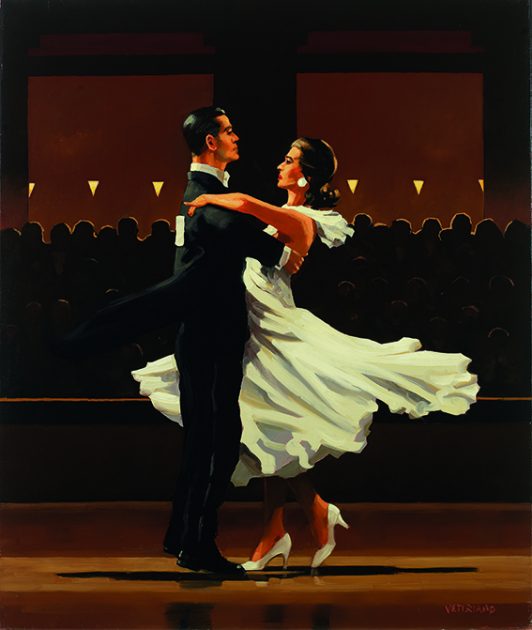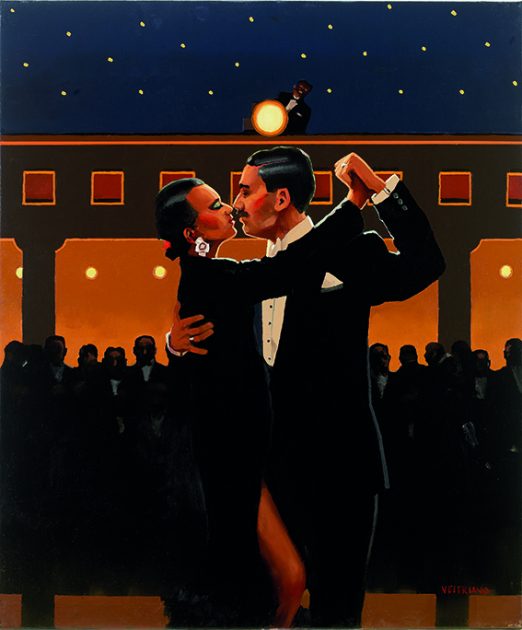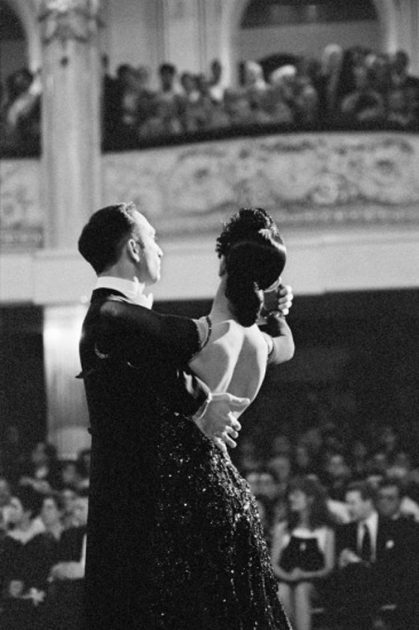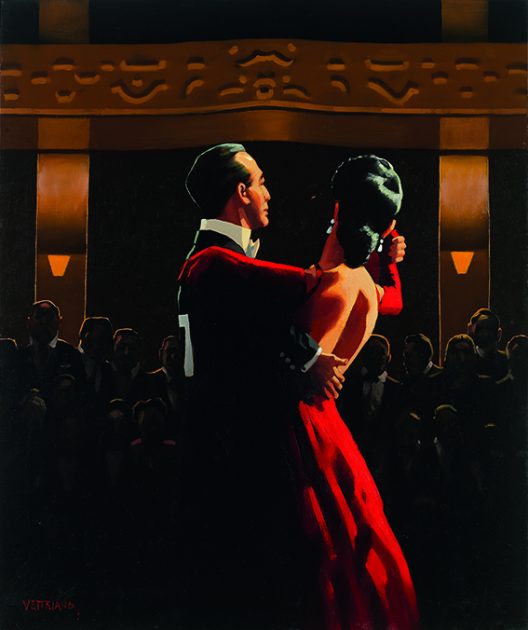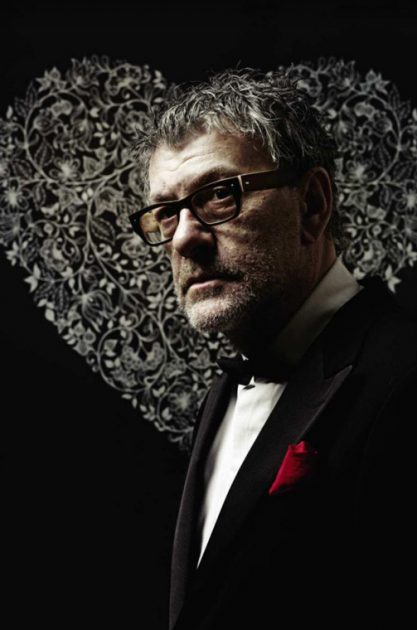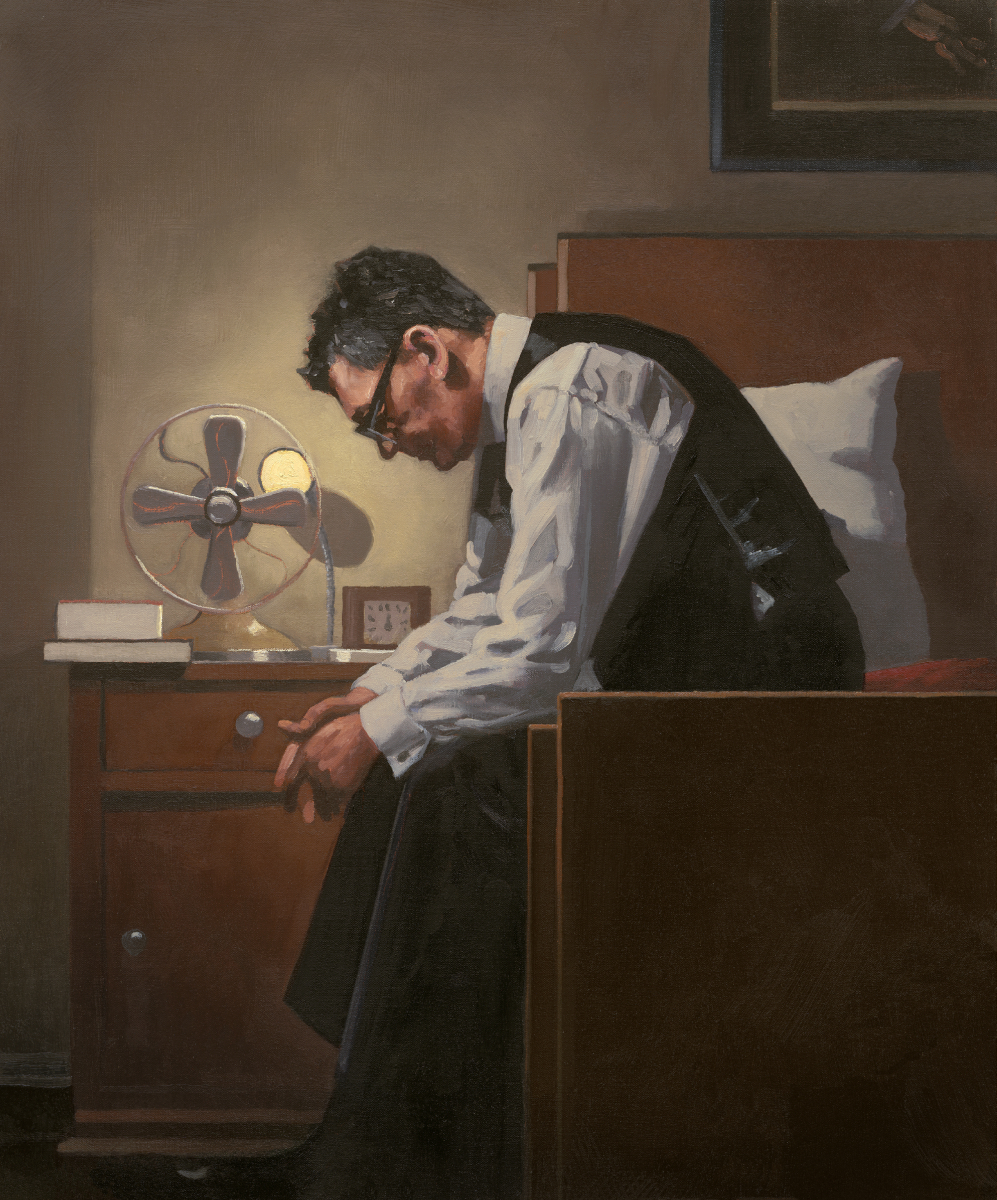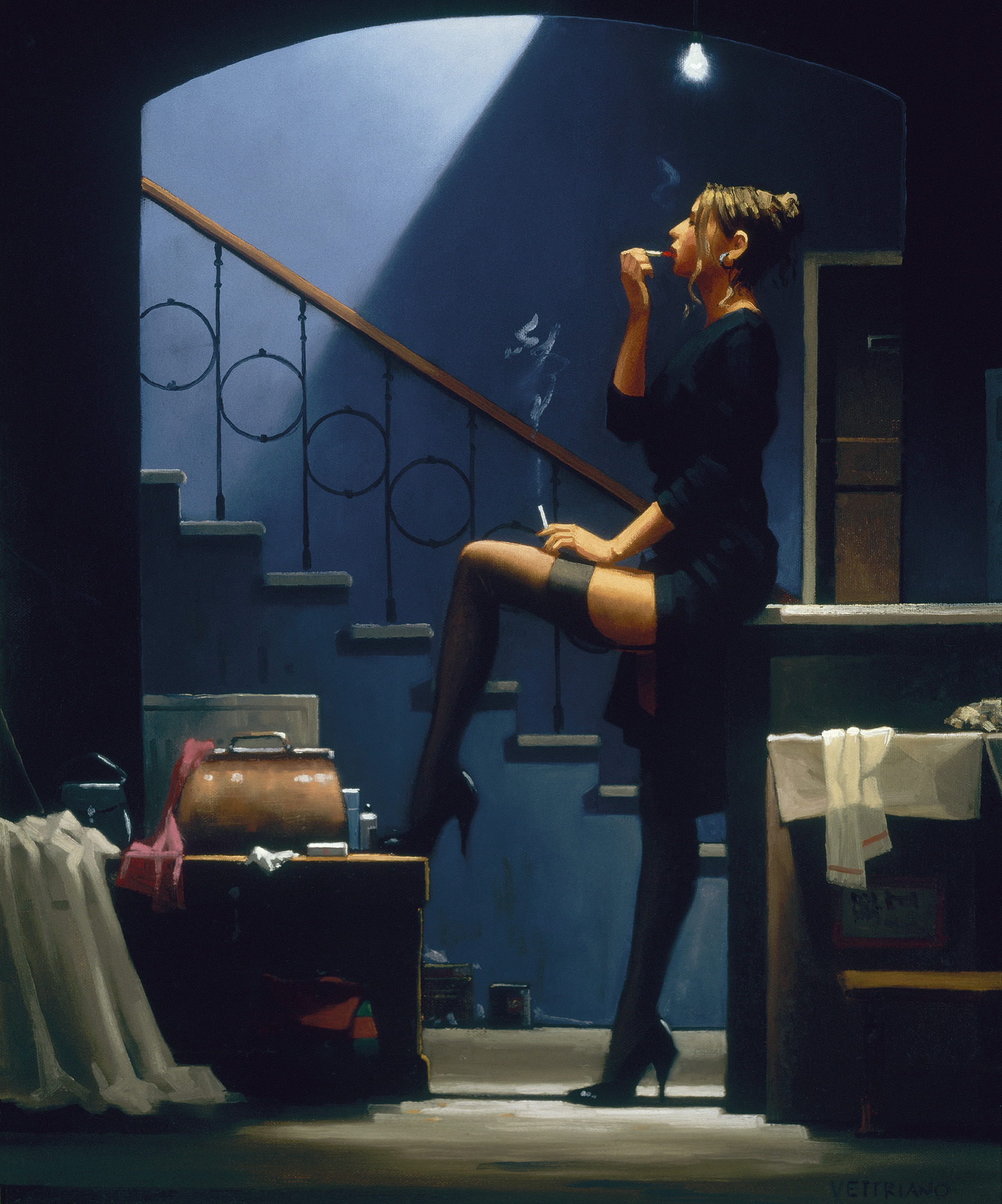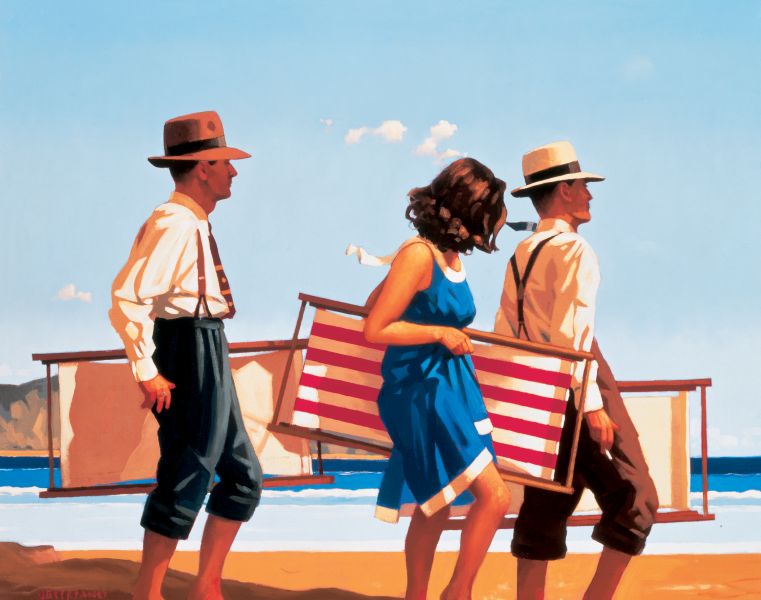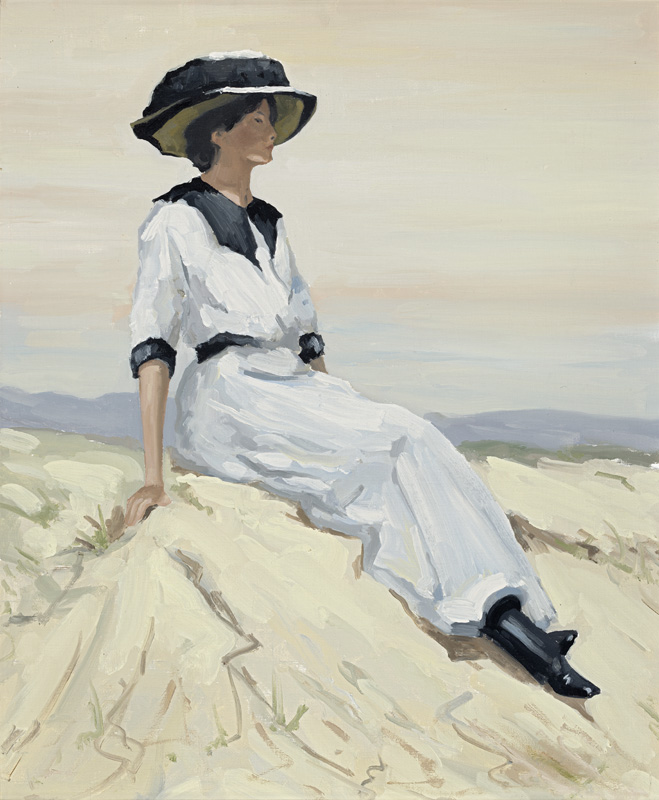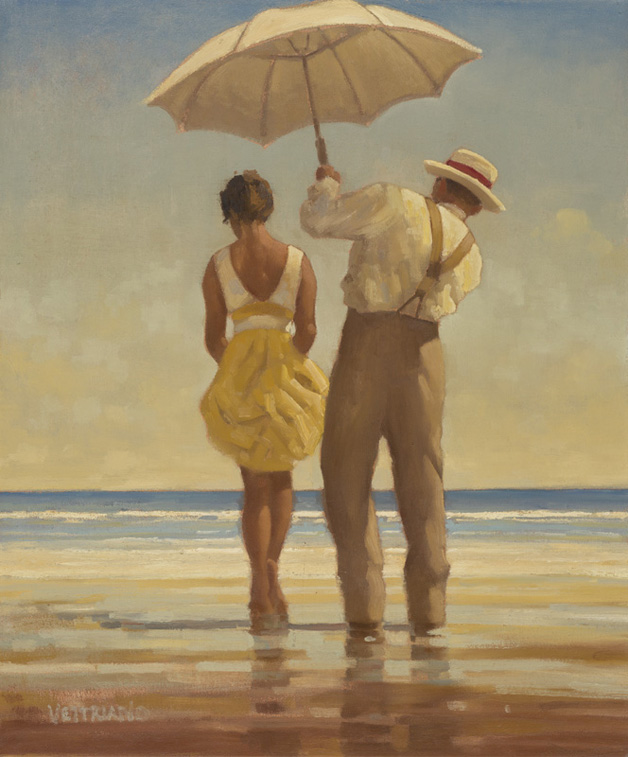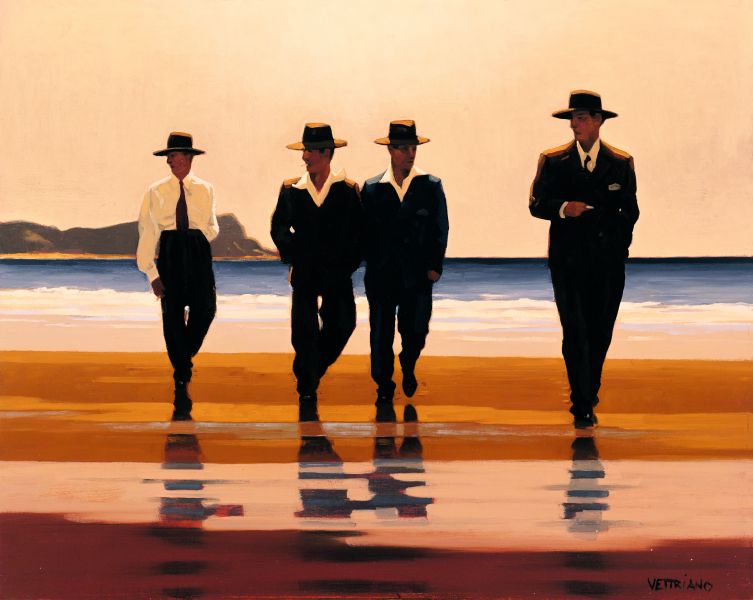It is with great sadness that we share the news of Jack’s passing over the weekend. He was not only an extraordinary artist but also a deeply private and humble man who was endlessly grateful for the support and admiration of those who loved his work. His paintings—capturing moments of intrigue, romance, and nostalgia—touched the hearts of so many around the world, and his legacy will live on through them. At this time, we ask for privacy as his loved ones come to terms with this loss. Thank you for all the kind messages and tributes already shared—your support means so much.
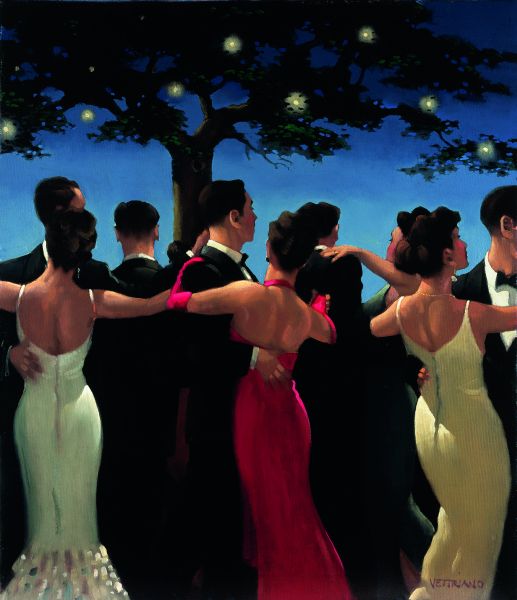
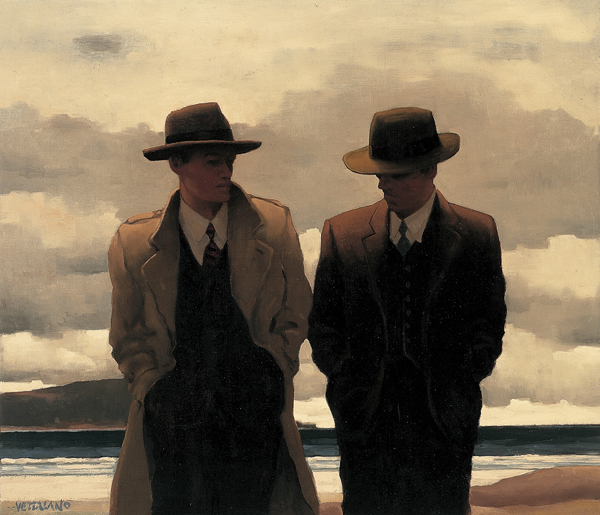
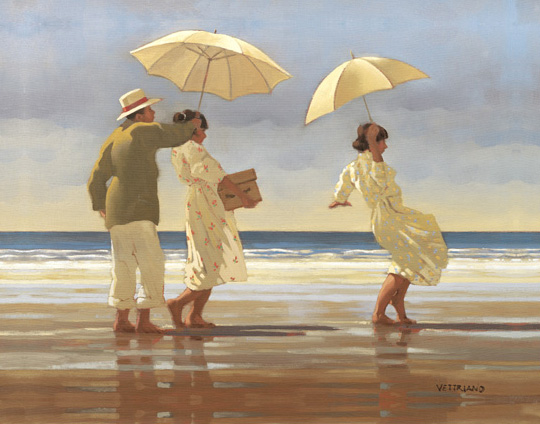
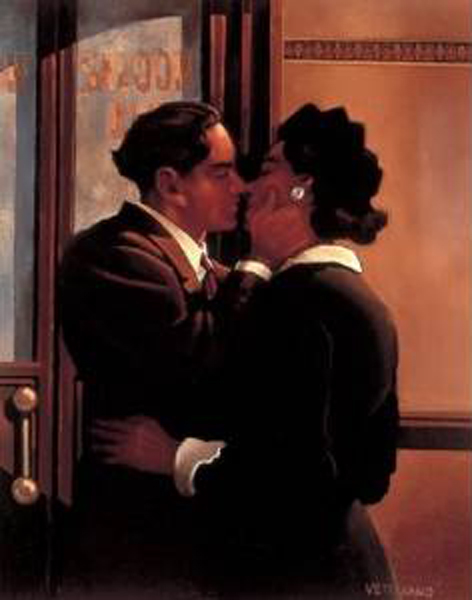
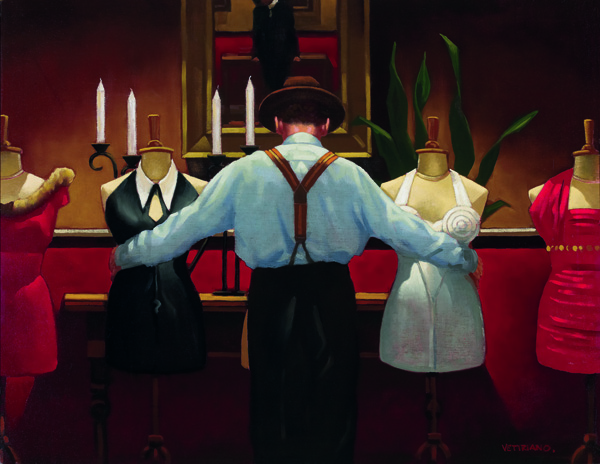

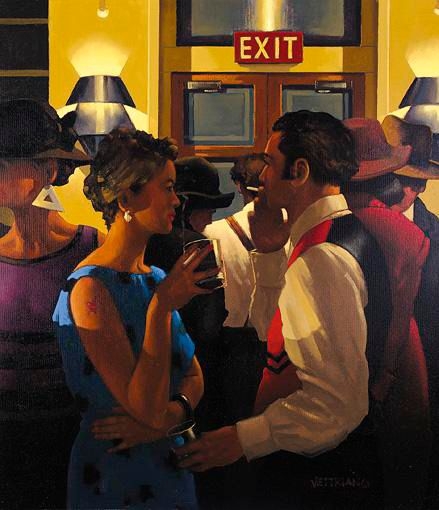
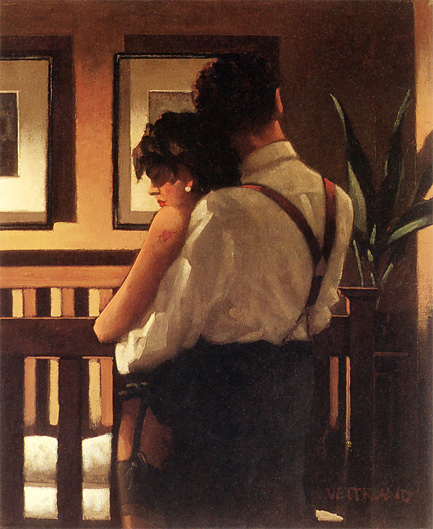
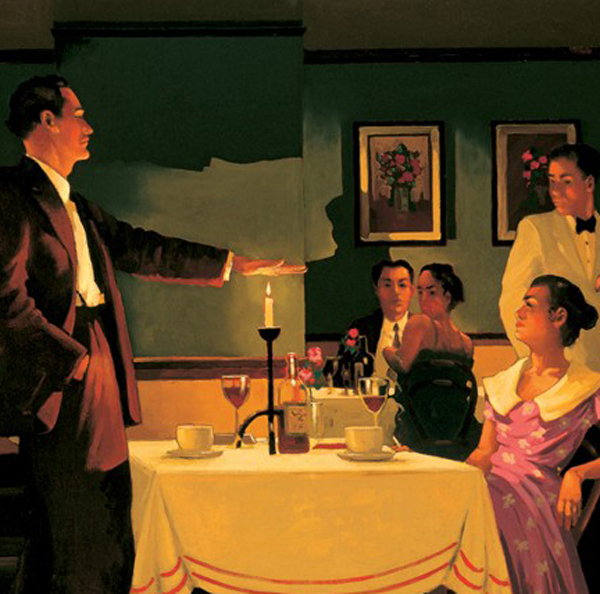
Tales of Love and Other Stories
The Edinburgh Gallery played host to ‘Tales of Love and other Stories’ between 15th May & 6 June 1992. It was significant in the artist’s career being his first solo exhibition. In the foreword of the catalogue, Jack writes “It was a long and sometimes difficult journey but I did so enjoy the experience” Gently taking his friend’s arm he whispers with such assurance and affection, “Come lets walk along the beach and let me tell you tales of love and other stories”.
Also in the catalogue is an eloquent three-page insight into the origins of the artist and a glowing review of his work by W Gordon Smith, art correspondent for the Scotland On Sunday. Writing with no small amount of admiration for Vettriano’s artistic talent, he wrote “if it is a wonder that he has managed to teach himself drawing, perspective, the manipulation of paint in veiled glazes and meaningful shadows, the music of colour and the dramatic focus of compositions, it is even more remarkable that he has evolved such an identifiable personal style”.
The exhibition comprised thirty-six paintings and included such classics as ‘Waltzers’ and The ‘Amateur Philosophers’. The body of work covers a variety of scenes ranging from his trademark beaches and brollies in ‘The Picnic Party’ to the intimacy and romance of ‘Ae Fond Kiss’. It featured three different versions of ‘A Kind of Loving’ where a male figure looks on with adoration to an array of interestingly attired tailor’s dummies. The complicated relationships which Jack depicts are confirmed with no fewer than three paintings which feature ‘betrayal’ in the title. One of the more interesting titles in Jack’s body of work is ‘Queen Of The Fan-dan’ – the Scots abbreviation of ‘Fancy Dan’ meaning a flashy ostentatious person and used mainly as a light hearted insult. The scene shows a lady resplendent in red, the obligatory cigarette in hand providing a light for a smart suited male with a three pronged silver candelabra. ‘The City Café’ is an Edinburgh diner which is a longstanding favourite with locals and visitors to the city alike. The lady in blue has the same arrowed heart tattoo on her arm as the lady in ‘Betrayal, No Turning Back’. ‘A Test of True Love’ is a modern homage to Vincent Van Gogh who’s overzealous romantic pursuit of his recently widowed cousin Kee saw him hold his left hand in the flame of a lamp with the words ‘Let me see her for as long as I can keep my hand in the flame.
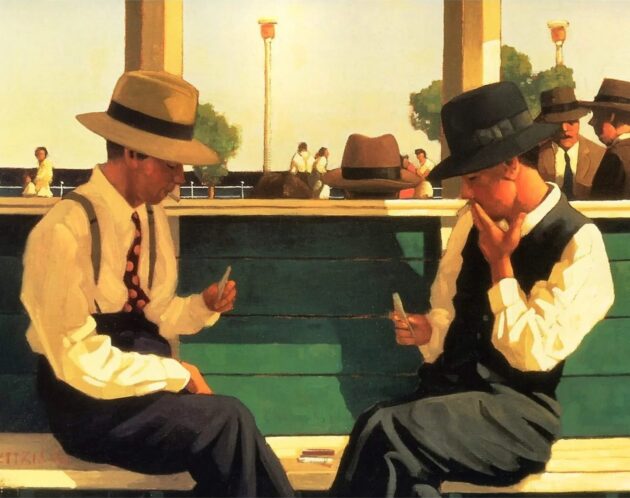
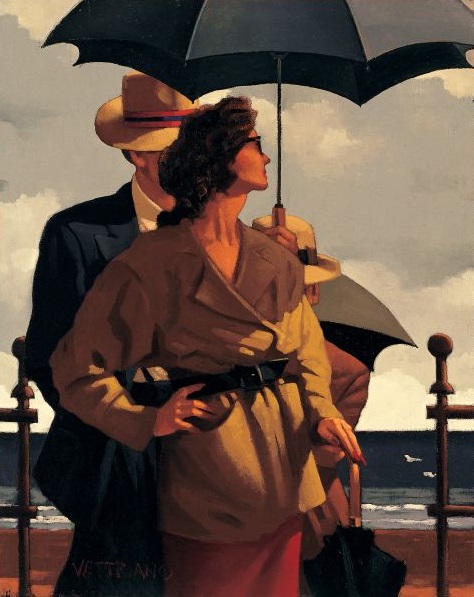
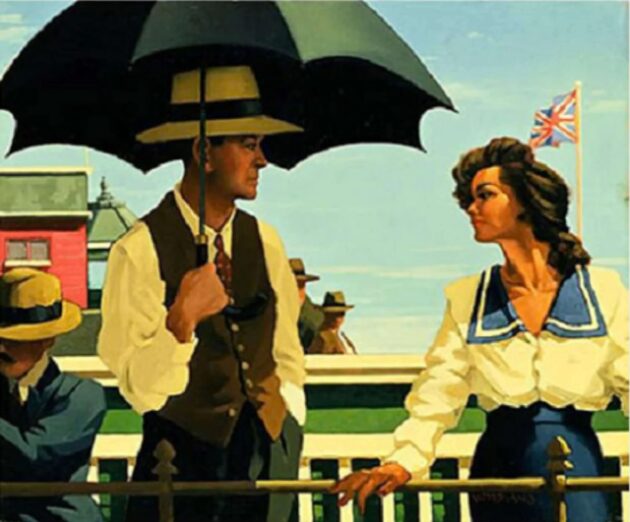
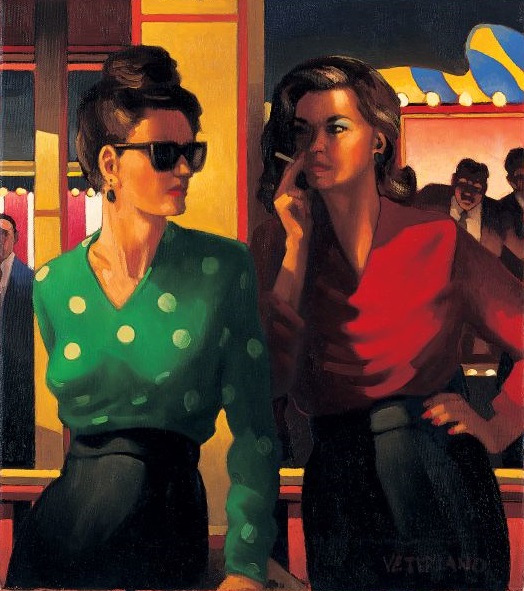
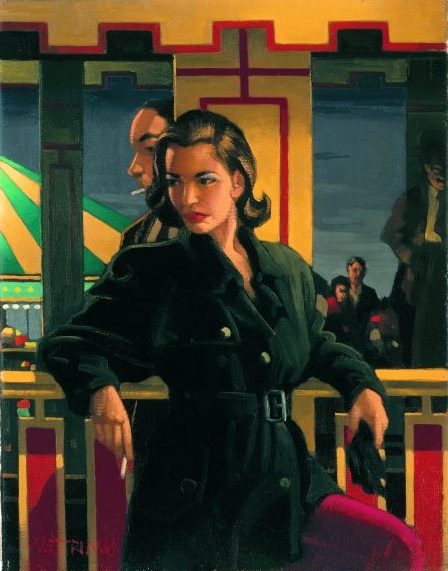
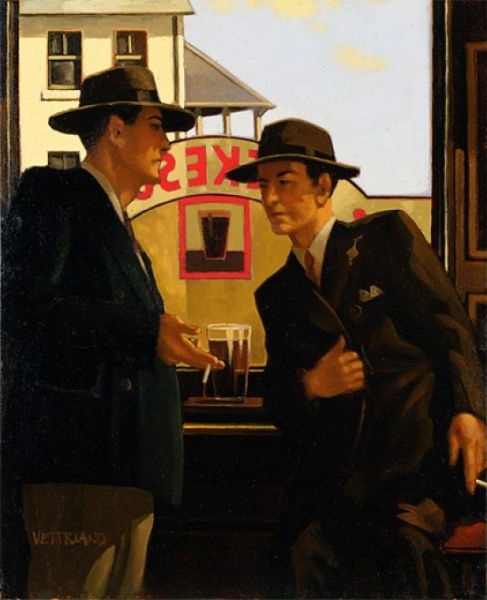
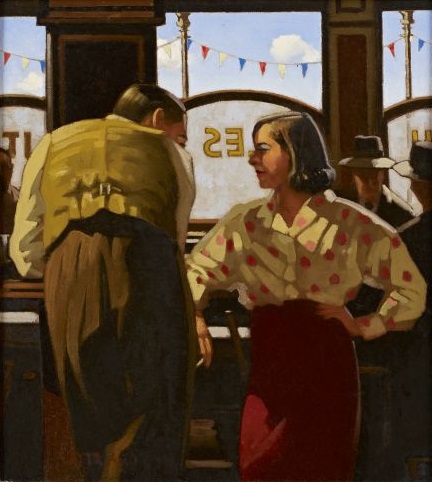
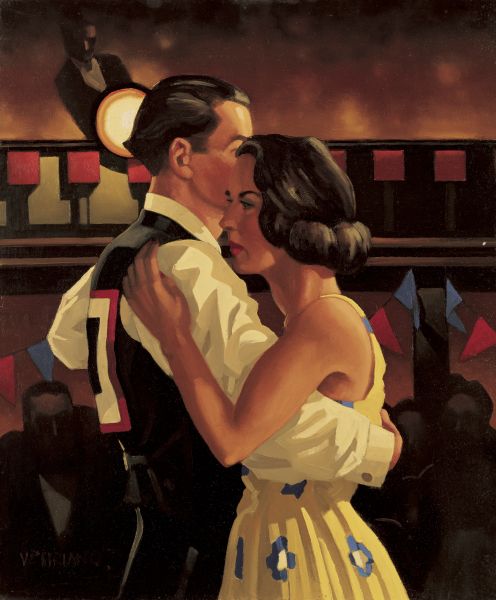
Summers Remembered
Corrymella Scott Gallery in Newcastle played host to an exhibition entitled “Summers Remembered – Oil paintings by Jack Vettriano” from 12th November to 3rd December 1993. A 28- page catalogue was released for the event containing a full list of the 25 paintings exhibited and contained images of 16 of those paintings and a three-page foreword by Vivien Hamilton, Curator of Art at Glasgow Museums. Hamilton interviewed the artist in an STV television documentary based on his painting which was first broadcast in May 1991. Hamilton observes “To enter a room full of the paintings of Jack Vettriano is to enter a world of intrigue – a world populated with glamorously dressed, available women and de-mob suited, attentive men. A world often discerned through a haze of cigarette smoke, through the lamp-lightened darkness of a bar or through the sun-drenched breeziness of an umbrella on a beach promenade. Each painting invites the viewer into a world of which drama forms the very heart”.
Born out of Vettriano’s own childhood and adolescence came an interest in fairgrounds and fairs, for the beach and promenade. This exhibition illustrates perfectly the artist’s ability to enclose his figures in strong compositions – architectural features such as the promenade’s metal railings provide the perfect framework of verticals and horizontals against which ‘Seaside Sharks’ repose. ‘The Duellists’ captures a pair of smartly dressed card-playing men against the background of the green painted shelter reminiscent of Paul Cezanne’s ‘The Card Players’ or the Cardsharps by Caravaggio. Black umbrella’s afford cover to the protagonists in ‘Right Time, Right Place’ and ‘Summertime Blues’ whilst it is perhaps the male figure holding the cream umbrella who requires protection from the steely glare from behind the sunglasses of a lady in the yellow spotted dress. The arm on hip highlights her gritty determination, the outstretched palm perhaps a placatory gesture by the male. The theme of confident independent women extends into ‘Good Time Girls’ and ‘The Main Attraction’ where the ladies stand challengingly waiting, often appearing calculating, never vulnerable or uncertain. We visit the inside of the local pub where the ‘Gambling Boys’ enjoy a pint and ‘The Barmaid’s Fancy’ oozes sexual chemistry with her confident demeanor and strong eye-contact. ‘Dancing Couple’ depicts a competing pair gliding across the floor hinting at the artists passion for dance to be later reinforced in the 2011 exhibition ‘The Ballroom Spy’.
Art critic for the Scotland on Sunday W Gordon Smith wrote “Summers Remembered is Jack Vettriano’s latest sortie into that hinterland half-world in which so many of his subjects – guys with snap brim fedoras and lipstuck gals in sexy satins- hover with intent, flirt engage, put themselves in the marketplace. There are fewer sinister and overtly erotic images in this vigorous new work – most of which sold at the private view – but his conjuring of small human dramas, his evocation of yearning and confrontation and conquest, sparks off countless scenarios, and tingles the roots of folk memory. His beaches are places of assignation and encounter. His seedy rooms are dangerous traps or corridors to fresh adventure. And his management of paint and light and the lure of shadows grows in confidence”.
Anyone who looks at my work knows I’ve been a naughty boy
Jack Vettriano tells Stephen McGinty about tapping into fantasies, his National Galleries snub and why he doesn’t care about being cancelled.
The weather in Nice is not very nice. A warmth is in the air but the sky, so often an azure blue, is today a slate grey of dirty clouds. But Jack Vettriano doesn’t mind. The city on the French Riviera has
been his home for almost 20 years and he’s used to these fleeting scowls. He still keeps his flat in London and another in his native Kirkcaldy, but his grand suite of rooms, in a belle époque apartment
block just behind the famous Negresco hotel on the Promenade des Anglais, is home for most months of each year. Sitting in the apartment, which is decorated in his distinctive art deco design, Scotland’s most famous — and arguably most infamous — artist explains: “I just love the south of France. I go as far west as Cannes, as far east as Ventimiglia, which is over the border in Italy. I just
love it and what I enjoy almost as much as anything is the anonymity. I’ve been recognised three times. In Edinburgh it was difficult to get through a day. I don’t get off on fame.”
As W Somerset Maugham wrote, the Cote d’Azur is a “sunny place for shady people”.
Yet next month Vettriano is coming home and stepping back into the spotlight for the launch of a big exhibition in his home town. Jack Vettriano: The Early Years at the Kirkcaldy Galleries contains over 50 works, including many of those from his most fertile creative period, between when he lived in Edinburgh in 1990 and moving to London in 1998, such as The Singing Butler and Mad Dogs. The exhibition will also include previously unseen early works, when in his apprenticeship in paint he copied works from the masters.
The decision to include clumsy early efforts is one of which he is quite proud. “It’s really important that people see that,” he says. “It gives them hope. They can look at my later work and be, perhaps, intimidated by it, if they paint, but if you look at the early work you can see clearly that I struggled.”
There is a refreshing honesty about Vettriano, a former miner who was given his first set of paints by a girlfriend on his 21st birthday and through dogged determination taught himself to conjure up
works that have both shocked and delighted the world. Celebrity collectors of his paintings include Madonna and Jack Nicholson, and in 2004 The Singing Butler, his most famous work, sold at
auction for £744,800 — then a record for a Scottish painting. If sold today it would be worth millions.
When the Daily Record revealed the basis for some of his images, he said he was proud to have created iconic images with only the help of a £17 art manual.
The world that Vettriano has created over the past 35 years, one canvas at a time, is a dark, emotionally desolate landscape of art deco bedrooms and sitting rooms where the desired and the unloved cautiously interact in an atmosphere perfumed by the musky scent of lust. The men have stepped into these rooms from a Forties film noir, all suits and braces and snap-brimmed fedoras, while the women are brunettes clad in corsets and silk stockings — what Martin Amis described as “the demonology” of lingerie.
I ask Vettriano why he believes so singular a vision of male desire has proven so incredibly popular with the Scottish public. He speak slowly, thoughtfully: “I think I touch on the needs — well, perhaps the sexual needs, or the romantic needs — of people, because I think most people have a tendency to shield their deepest needs and fantasies. And I think what I have done is I have created in my paintings a whole new world that they can step into and step out of, whereas I am stuck in it.”
The dry kindling that ignites his artistic inspiration is broken relationships. In the past he’s admitted to ending a love affair that felt too comfortable in order to experience the frisson of regret and recrimination then seek to imprison it in paint. In Edinburgh during the Nineties, he admits he was a frequent patron of prostitutes and the city’s massage parlours, and that the themes of dominance and desire found within the picture frame are largely autobiographical.
I ask if he ever regrets being too honest about the personal source of his artistic inspiration.
“I take the view that the public deserve more than a bag of lies. That is to say, I think anybody who looks at my work knows that I’ve been a naughty boy. I don’t do half of that stuff now as much as I would like to. But I think for honesty — it was Billy Joel who has a song called Honesty and who says it’s such a lonely word because everybody is so untrue. I think, yes. It’s why I’ve turned down opportunities to do a biography, because I wouldn’t paint over — sorry to use the term — I don’t want to sit with a ghost writer and talk a lot of shite and I can’t be honest because it’s all triple-X certificate.”
Given the current artistic climate, has he ever had concerns about being cancelled?
He falls silent for a few seconds, then asks back: “What do you mean by being cancelled?”
Well, I explain, his work frequently features young women in various states of undress for the explicit sexual desire of older men. Paintings such as A Sinister Turn of Emotion, in which a young woman prepares to remove her underwear ahead of corporal punishment; or Home Visit, in which a young prostitute in black slip and stockings spreads her legs for a besuited older client. Would older works still be “acceptable” today?
“Well, I don’t much give a f*** and you can quote me on that. Any artist worth the name has to be true to himself. People have called my work misogynistic, but I can tell you that women are the biggest fans of my work and that I find very interesting. I don’t apologise for what I have done and what I have painted. It is more or less autobiographical and I would argue that with anyone. I am being honest with myself and I’m not prepared to stand in line and be politically correct.”
Would he consider bending with the times?
“Christ, no. I’m not worried about that and my new paintings reflect that. I’m still painting from the heart. I’m still painting with integrity. I’m not painting so men can get off on them. I’m painting them because that’s the world I live in.”
He no longer visits brothels or hires escorts, and says he hasn’t for a long time, fearful of being a target for a media sting “like Angus Deayton”. Yet at 70, he is considering a long-term relationship, if he can find the right person. “I would like to meet someone, but I think I’d like her to have a flat next door. I still have hope that there is someone out there prepared to take me on and look after me.”
An ill-timed visit to the capital meant he spent the first Covid lockdown as the only guest at the Edinburgh Grand hotel in St Andrew Square: “I was like Jack Nicholson in The Shining.” Apart from a daily visit to Sainsbury’s for food, he lay on the bed and watched TV. He has a complicated relationship with Scotland’s capital, the home of the art establishment. His previous show was in Glasgow, and he has chosen to go home to Kirkcaldy for the latest retrospective. For in an act of stubborn perversity, the National Galleries of Scotland have long refused to buy a single painting by Vettriano, exuding the air that a grubby working-class oik has no place on their walls, despite his commanding public support.
It is a bone of contention on which Vettriano continues to chew. “The national gallery has an annual budget for new acquisitions and there is a committee who decide what artists’ work they want. If they were being honest to the public, because it is taxpayers’ money, they would give what the taxpayer wants and I would be fairly high on that list.”
When he met Sir John Leighton, the director-general of the National Galleries of Scotland — “we weren’t unkind, we were polite” — and asked when they would buy one of his paintings, he said
Leighton replied: “We are doing it in alphabetical order.”
When the skies clear over Nice, Vettriano likes to walk down to the beach. His work has long been divided between light and dark, between sex and romantic paintings such as Dance Me to the End of Love. In the past the ratio was 75 per cent dark and 25 per cent light. Nice, it seems, has brought out his brighter side. “I’d say it’s about 50-50 now.”
There are no paintings he regrets. “I would stand by everything I’ve done. Every painting I’ve put out. I think perhaps there might be one or two I would change but they were of their time. That was my mindset at the time when I painted them. But my new work that I’ve done is just as sexual.”
I ask what is on his easel, and he lets out a chuckle.
“It’s a women in her underwear and she’s on a balcony and she’s making a phonecall and she’s in fetish underwear — black — and she’s obviously, in my mind, she’s speaking to a client or a pimp and she’s going to make someone happy.”
By Stephen McGinty in the Sunday Times 15th May 2022
Jack Vettriano: The Early Years – The Scotsman Coverage
Media coverage from The Scotsman in anticipation of the re-scheduled exhibition, Jack Vettriano: The Early Years at Kirkcaldy Galleries in 2022.
Jack Vettriano: The Early Years
Kirkcaldy Galleries is exhibiting a selection of paintings created by the artist from the time he began painting in his early 20’s until he moved to London in 2000. Among the work being showcased there will be a number of paintings signed with the artist’s birth name Jack Hoggan. These paintings show the diversity of subject matter and styles tackled by the young artist in learning his craft, eventually giving him the confidence and technical ability to develop his own identifiable style. The majority of the exhibition is devoted to work from Vettriano’s exhibitions in Edinburgh, Newcastle and London from 1990 – 2000 and included are a number of the artists most definitive and best loved works which were produced during this period. All the paintings are on loan from private collections and many of the paintings have never been on public display.
The painting shown here is an unsigned Hoggan after James Herbert Gunn which is part of the exhibition and can be seen at Kirkcaldy Galleries.
Jack Vettriano said ‘l’m delighted to be returning to my former home town of Kirkcaldy for a major exhibition of my early work which is fitting as its where my formative years as an artist began’.
From 17th June to 23rd October 2022 at Kirkcaldy Galleries
Exhibition sponsors are Dickson Minto.
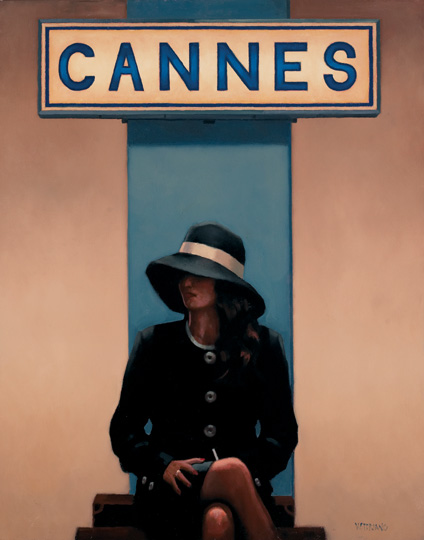

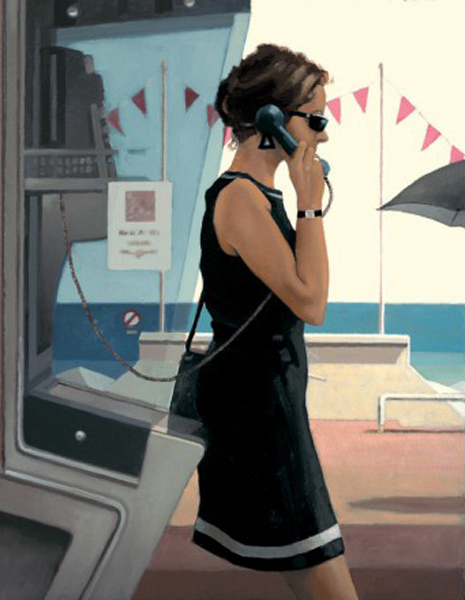
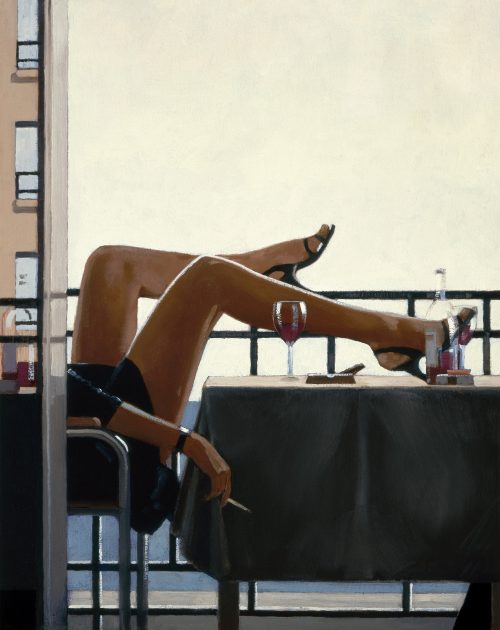
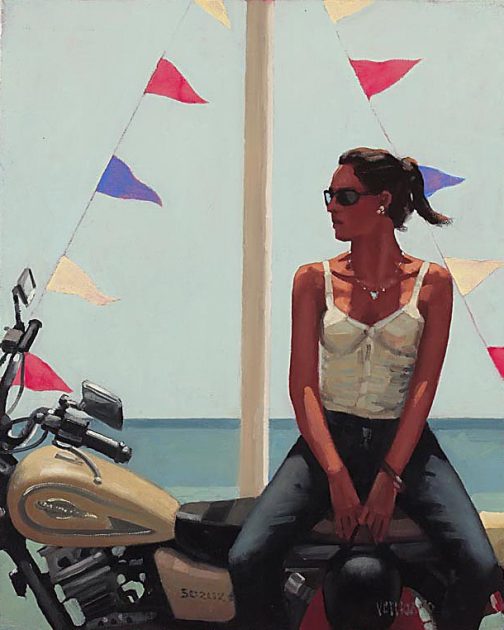
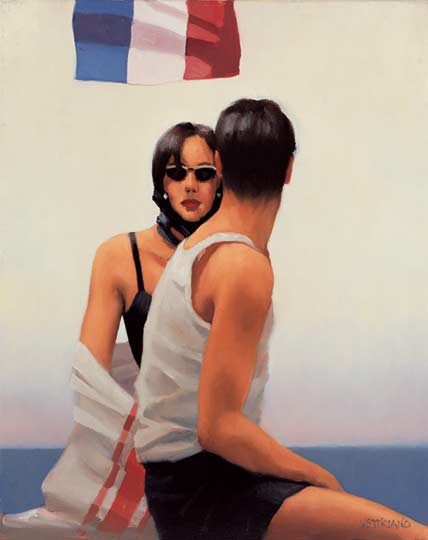
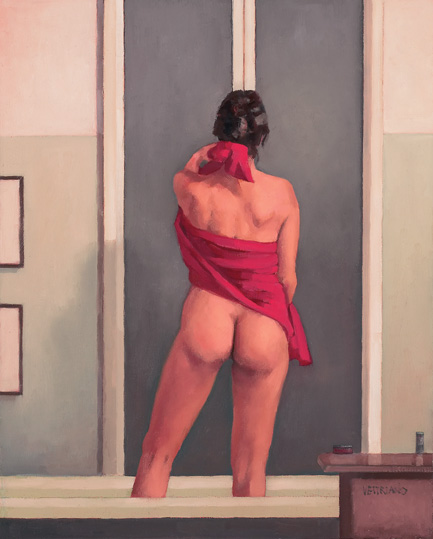
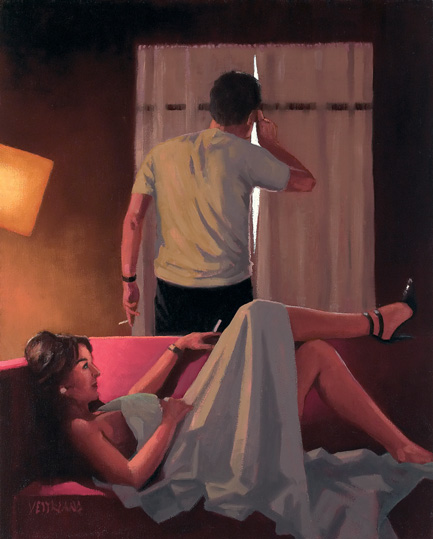
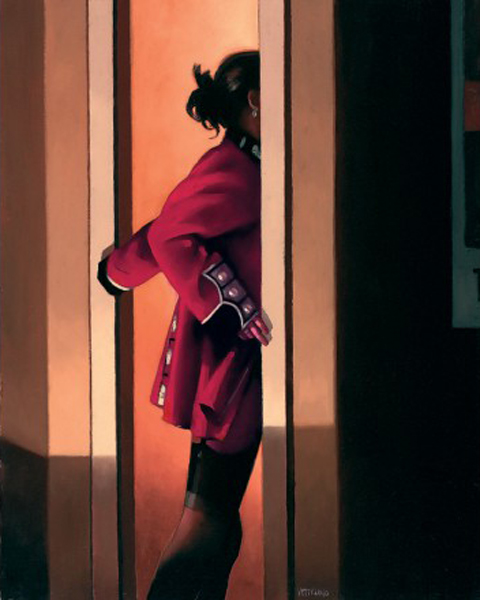
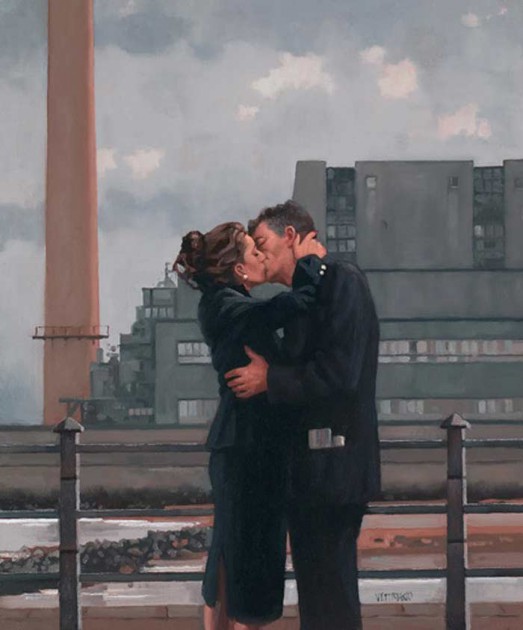
Exhibitions Revisited: Love, Devotion and Surrender
‘Love, Devotion and Surrender’ exhibition opened in April 2006 and it was Vettriano’s tenth and final exhibition with Portland Gallery in London.
After acquiring a studio in the South of France Vettriano took much inspiration from the environment around him and this was very heavily reflected in the paintings that he produced for this exhibition. As well as Vettriano’s better known darker imagery we also see his use of lighter and brighter aesthetics from beach scenes to convertible cars located in and around Nice. In this exhibition Vettriano proves he is equally adept at using the subtleties of light and shadow to help create the atmosphere of the situation in which his characters exist.
At the time of the exhibition BBC Scotland sent a crew to film at the gallery and to interview Vettriano about his latest collection of paintings.
‘Suddenly One Summer’ from Vettriano’s Knightsbridge flat goes on sale
A door in Vettriano’s former flat in Knightsbridge London which the artist painted a portrait of a model on has sold at auction. The painting ‘Suddenly One Summer’ sold for £50,000.
Click here to read the full article
Jack Vettriano: The Early Years – The Herald Coverage
Media coverage from the Herald in anticipation of the re-scheduled exhibition, Jack Vettriano: The Early Years at Kirkcaldy Galleries in 2021.
Click here to read the full article
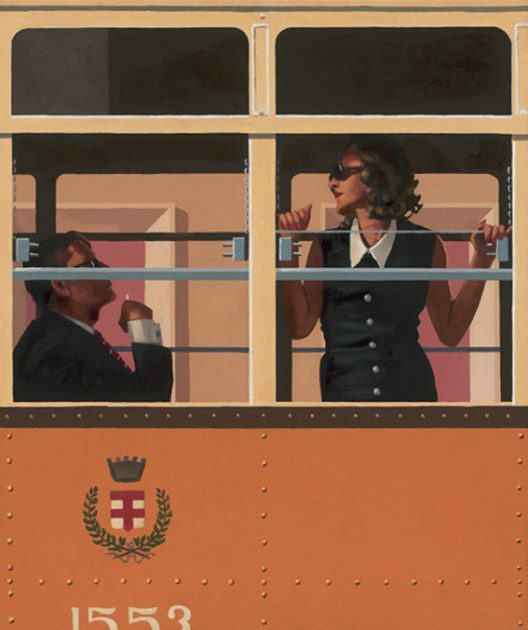
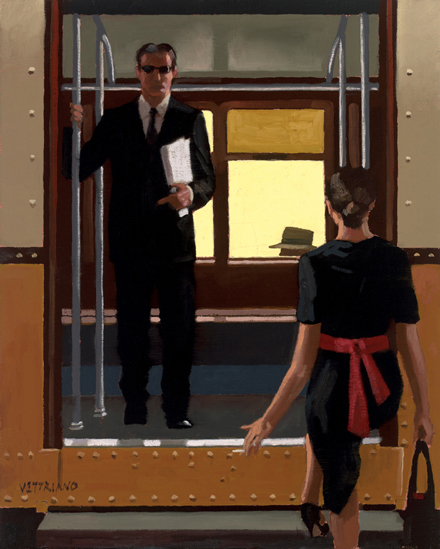
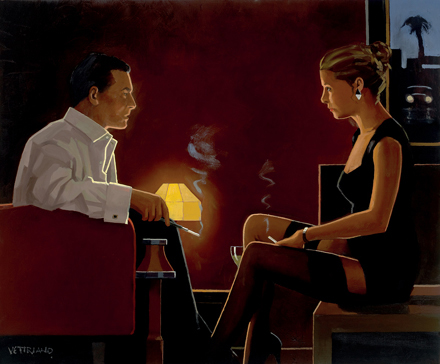
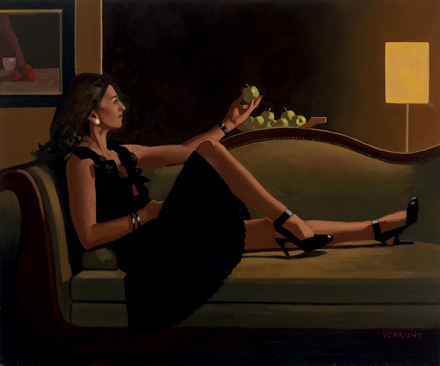
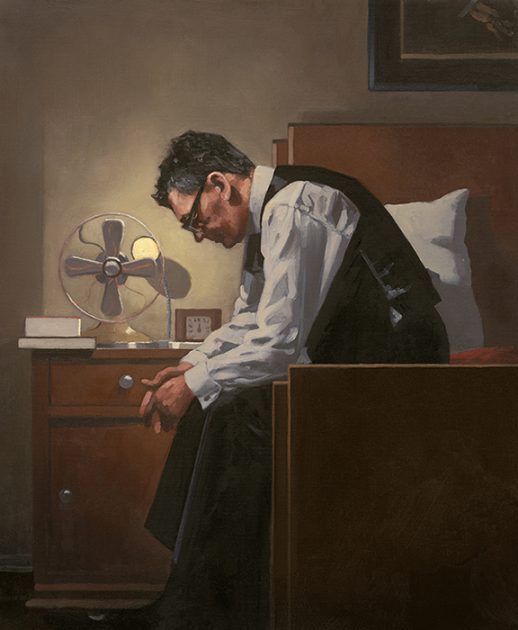
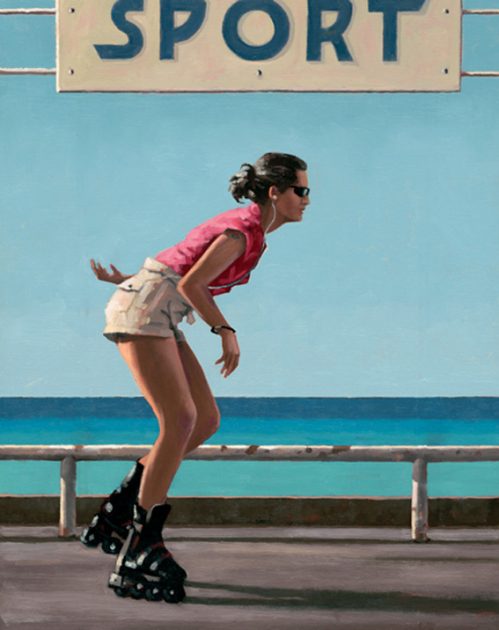
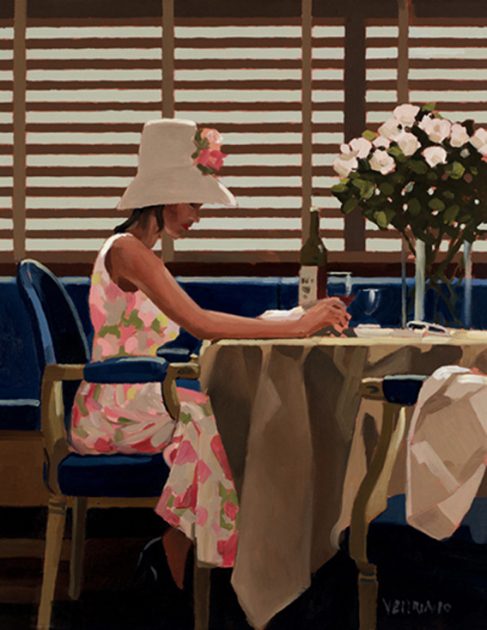
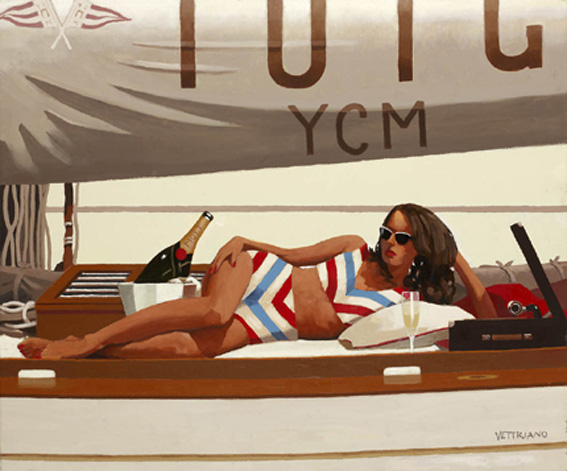
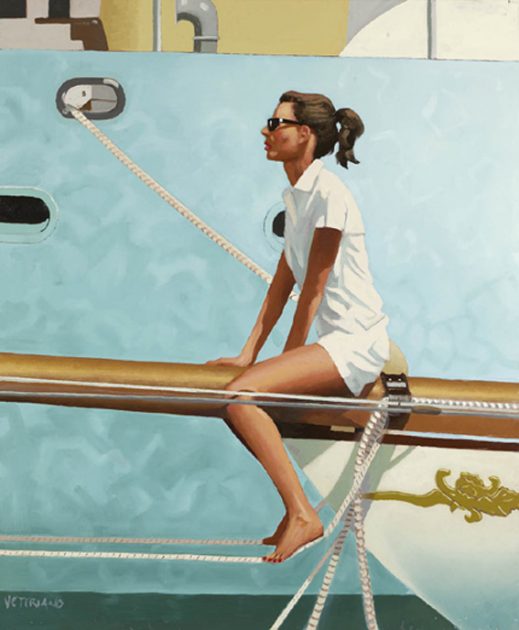
Exhibitions Revisited: Days of Wine and Roses
Following on from ‘The Ballroom Spy’ exhibition in 2011 we shall turn our attention to Vettriano’s ‘Days of Wine and Roses’ exhibition. Taking place at Kirkcaldy Galleries from March 2010, the exhibition offered a glimpse into some memorable moments and places in Vettriano’s life in the preceding years.
The exhibition started with a sequence of paintings inspired by Vettriano’s visit to Milan when the artist visited the city to record a television interview. Milan’s main mode of transport, the “Giallo Milano” trams, immediately caught Vettriano’s eye with their distinctive cream and yellow livery and beautifully restored interiors of chrome. This quickly led to Vettriano being given the opportunity to stage a photo shoot at the Via Messina tram depot.
Vettriano collaborated with Fred Marcarini who shot the photographs for the tram sequence of paintings. The pair had met the previous year in London when Marcarini was commissioned to take a series of portrait shots of Vettriano for an Italian magazine, Monsieur. Featured in this exhibition Vettriano’s painting ‘The Weight’ was a response to one of Marcarini’s portraits shot in the artist’s home.
Another sequence of paintings that show a continental influence on Vettriano’s work were created as a result of an approach by the director of the Yacht Club of Monaco. The club suggested that a painting of their yacht, Tuiga would be a wonderful way to commemorate its centenary. Nine paintings evolved from the photo shoot at the Club, with vintage cars loaned by the retired racing driver, John Coombs and a model dressed in vintage clothing who posed with Vettriano both on Tuiga and in the Club itself. Homage à Tuiga was first exhibited in September 2009 at a private event at the Yacht Club of Monaco.
Whilst inspiration for many of the paintings in this exhibition came from locations around the world, we also see a glimpse into Vettriano’s studio life with paintings including Portrait in Black and Blue and La Femme au Chapeau Noir. Alongside these studio paintings the exhibition featured some of Vettriano’s signature darker interior, exploring the more erotic side of his imagination.
